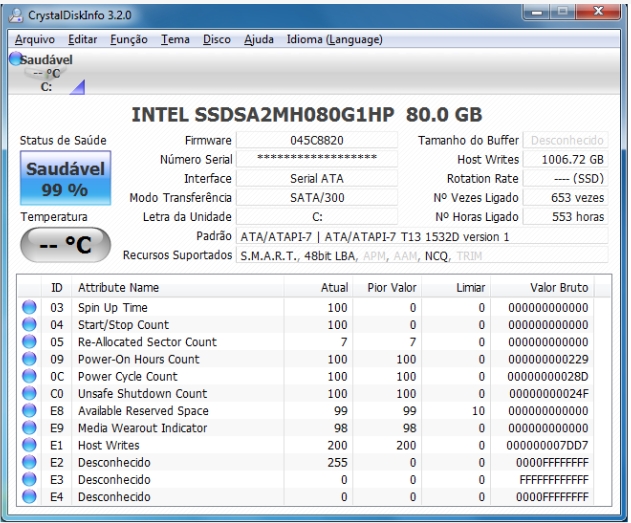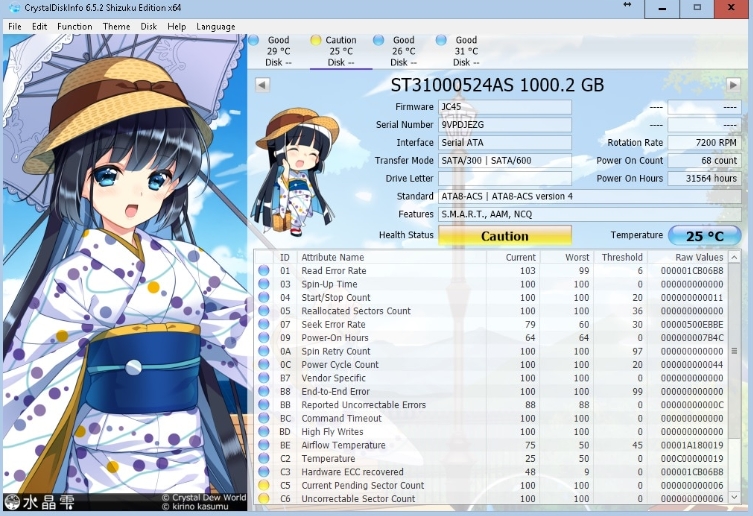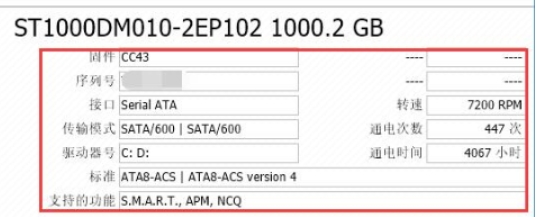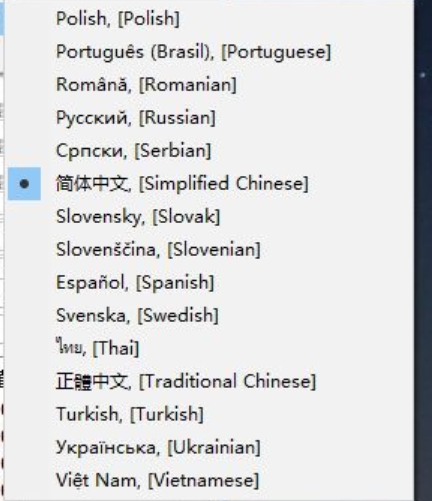 Software Tutorial
Software Tutorial
 Computer Software
Computer Software
 CrystalDiskinfo usage tutorial-What software is CrystalDiskinfo?
CrystalDiskinfo usage tutorial-What software is CrystalDiskinfo?
CrystalDiskinfo usage tutorial-What software is CrystalDiskinfo?
php editor Xinyi brings you a tutorial on how to use CrystalDiskinfo. CrystalDiskinfo is a free hard disk health monitoring software that can monitor the operating status and temperature of the hard disk in real time, helping users understand the health status of the hard disk in a timely manner and prevent data loss. This tutorial will introduce the functions and usage of CrystalDiskinfo software in detail, allowing you to easily master hard drive monitoring skills and ensure data security.

1. The origin of CrystalDiskInfo
As one of the three major components of a computer host, solid-state drive is the storage medium of the computer and is responsible for computer data storage. A good solid-state drive can speed up file reading and affect consumption. user experience. When consumers receive new devices, they can use third-party software or other SSD testing tools to test the performance of the hard drive and check the quality of the hard drive.

CrystalDiskInfo is a tool for monitoring and assessing the health of your computer's hard drive. It provides detailed hard drive information by reading the SMART (Self-Monitoring, Analysis and Reporting Technology) data of the hard drive, helping users understand the usage, health status and possible problems of the hard drive.

You can get a comprehensive, detailed and intuitive understanding of the hard drive health status and various parameters, including hard drive temperature, serial number, drive interface, power-on time, power-on times, etc. The software will also make an evaluation based on the S.M.A.R.T score and will issue an alert when the hard drive is about to be damaged.

2. How to use CrystalDiskInfo
first step
Open the CrystalDiskInfo obtained after decompression, and you can see all relevant information about the computer's local hard disk in the main page interface.

Step 2
Use the drop-down list to check the working status of the hard drive and various health values to find the point of damage.

third step
If the "Theme" tab is used, then under this tab we can also set the display size, font, color and other information of the window

the fourth step
Special reminder: when downloading this software, if the downloaded software interface is in English, you can modify the language of the interface through the "language" tab in the menu bar.

the fifth step
Click the "Function" button in the top menu bar, pull down the menu, and point the mouse to "Warning Function". You can set the warning method in the submenu.

Step 6
In the "Advanced Features" column of the "Features" option, you can select "AAM/APM Control Most Important".
Step 7
After completing the above steps, you will be able to set the noise and power properties of the hard disk to ensure that the most appropriate conditions can be adjusted when using the computer.

The above is the detailed content of CrystalDiskinfo usage tutorial-What software is CrystalDiskinfo?. For more information, please follow other related articles on the PHP Chinese website!

Hot AI Tools

Undresser.AI Undress
AI-powered app for creating realistic nude photos

AI Clothes Remover
Online AI tool for removing clothes from photos.

Undress AI Tool
Undress images for free

Clothoff.io
AI clothes remover

Video Face Swap
Swap faces in any video effortlessly with our completely free AI face swap tool!

Hot Article

Hot Tools

Notepad++7.3.1
Easy-to-use and free code editor

SublimeText3 Chinese version
Chinese version, very easy to use

Zend Studio 13.0.1
Powerful PHP integrated development environment

Dreamweaver CS6
Visual web development tools

SublimeText3 Mac version
God-level code editing software (SublimeText3)

Hot Topics
 How to use sql datetime
Apr 09, 2025 pm 06:09 PM
How to use sql datetime
Apr 09, 2025 pm 06:09 PM
The DATETIME data type is used to store high-precision date and time information, ranging from 0001-01-01 00:00:00 to 9999-12-31 23:59:59.99999999, and the syntax is DATETIME(precision), where precision specifies the accuracy after the decimal point (0-7), and the default is 3. It supports sorting, calculation, and time zone conversion functions, but needs to be aware of potential issues when converting precision, range and time zones.
 How to create oracle database How to create oracle database
Apr 11, 2025 pm 02:36 PM
How to create oracle database How to create oracle database
Apr 11, 2025 pm 02:36 PM
To create an Oracle database, the common method is to use the dbca graphical tool. The steps are as follows: 1. Use the dbca tool to set the dbName to specify the database name; 2. Set sysPassword and systemPassword to strong passwords; 3. Set characterSet and nationalCharacterSet to AL32UTF8; 4. Set memorySize and tablespaceSize to adjust according to actual needs; 5. Specify the logFile path. Advanced methods are created manually using SQL commands, but are more complex and prone to errors. Pay attention to password strength, character set selection, tablespace size and memory
 How to delete all data from oracle
Apr 11, 2025 pm 08:36 PM
How to delete all data from oracle
Apr 11, 2025 pm 08:36 PM
Deleting all data in Oracle requires the following steps: 1. Establish a connection; 2. Disable foreign key constraints; 3. Delete table data; 4. Submit transactions; 5. Enable foreign key constraints (optional). Be sure to back up the database before execution to prevent data loss.
 What are the oracle11g database migration tools?
Apr 11, 2025 pm 03:36 PM
What are the oracle11g database migration tools?
Apr 11, 2025 pm 03:36 PM
How to choose Oracle 11g migration tool? Determine the migration target and determine the tool requirements. Mainstream tool classification: Oracle's own tools (expdp/impdp) third-party tools (GoldenGate, DataStage) cloud platform services (such as AWS, Azure) to select tools that are suitable for project size and complexity. FAQs and Debugging: Network Problems Permissions Data Consistency Issues Insufficient Space Optimization and Best Practices: Parallel Processing Data Compression Incremental Migration Test
 How to update the image of docker
Apr 15, 2025 pm 12:03 PM
How to update the image of docker
Apr 15, 2025 pm 12:03 PM
The steps to update a Docker image are as follows: Pull the latest image tag New image Delete the old image for a specific tag (optional) Restart the container (if needed)
 Centos stops maintenance 2024
Apr 14, 2025 pm 08:39 PM
Centos stops maintenance 2024
Apr 14, 2025 pm 08:39 PM
CentOS will be shut down in 2024 because its upstream distribution, RHEL 8, has been shut down. This shutdown will affect the CentOS 8 system, preventing it from continuing to receive updates. Users should plan for migration, and recommended options include CentOS Stream, AlmaLinux, and Rocky Linux to keep the system safe and stable.
 How to add columns in PostgreSQL?
Apr 09, 2025 pm 12:36 PM
How to add columns in PostgreSQL?
Apr 09, 2025 pm 12:36 PM
PostgreSQL The method to add columns is to use the ALTER TABLE command and consider the following details: Data type: Select the type that is suitable for the new column to store data, such as INT or VARCHAR. Default: Specify the default value of the new column through the DEFAULT keyword, avoiding the value of NULL. Constraints: Add NOT NULL, UNIQUE, or CHECK constraints as needed. Concurrent operations: Use transactions or other concurrency control mechanisms to handle lock conflicts when adding columns.
 How to clean all data with redis
Apr 10, 2025 pm 05:06 PM
How to clean all data with redis
Apr 10, 2025 pm 05:06 PM
How to clean all Redis data: Redis 2.8 and later: The FLUSHALL command deletes all key-value pairs. Redis 2.6 and earlier: Use the DEL command to delete keys one by one or use the Redis client to delete methods. Alternative: Restart the Redis service (use with caution), or use the Redis client (such as flushall() or flushdb()).





